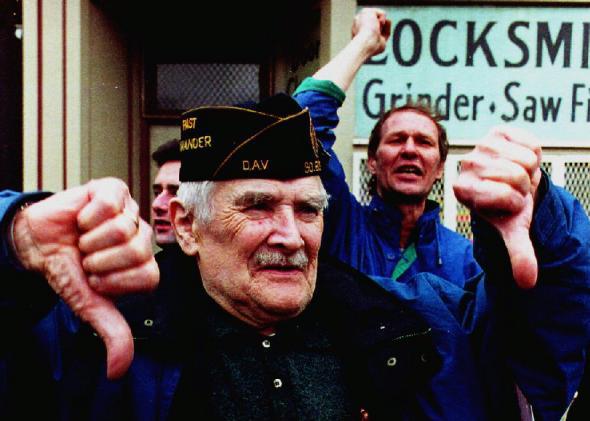Until yesterday, it looked like gay groups would be allowed to march in Boston’s St. Patrick’s Day parade for the first time in two decades. Under pressure from a new mayor who announced that he won’t participate in the parade unless the gay exclusion ends, the Allied War Veterans Council, which sponsors the event, had agreed to allow an LGBTQ veteran’s group to participate—but only if the word gay was absent from their clothing and signs. (By that logic, they might as well hold the parade in rural Tennessee.) On Monday, the deal fell apart when AWVC claimed the gay group was trying “to enter this parade under false pretenses.”
This green-tinted anti-gay animosity isn’t limited to Boston, of course: New York City’s new mayor Bill de Blasio announced that he would boycott the world’s largest St. Patrick’s Day parade because it, too, prohibits openly gay groups from marching. Why are these high-profile events in liberal East Coast cities such hotbeds of bigotry?
Boston’s exclusionary history began in 1992 and 1993, when local courts ruled in favor of the Irish-American Gay, Lesbian, and Bisexual Group of Boston—known as GLIB—which wanted to march in the St. Patrick’s Day parade. The massive procession through Southie—Boston’s traditionally Irish, predominantly Catholic neighborhood—is heavy on veterans groups, police departments, and local politicians. Although AWVC’s parade—which attracts more than 1 million spectators each year—is privately organized, it is partially funded with taxpayer dollars. (The Boston Globe reports that the 2013 parade cost the city more than $315,000 in police overtime alone.) Consequently, courts agreed that the organizers had unfairly discriminated against GLIB.
GLIB’s legal victory didn’t translate to a warm reception from parade-goers, though. Gay marchers faced slurs, spit, smoke bombs, and snowballs from dozens of spectators along the parade route, in what the Boston Globe referred to as “a 5-mile gantlet of hostility that sometimes threatened to erupt into wide-scale violence.” Thousands more parade-goers, some of them wearing T-shirts bearing the words “90 Years Without Queers,” turned their backs when the group passed. Riot police marched alongside the GLIB contingent in order to maintain calm.
After 92 consecutive years of celebrating Boston’s Hibernian heritage, the AWVC canceled the 1994 parade rather than allow LGBTQ Irish-Americans to participate. The organizers were adamant in their homophobia. Former Mayor Thomas Menino asked as many as eight other local organizations to take over the planning of the parade, but all stood together in anti-gay solidarity. In 1995, the AWVC appealed all the way to the Supreme Court, which (correctly) recognized the private organizers’ right to exclude groups. (If this seems unreasonable, imagine a Gay Pride parade being forced to include Fred Phelps’ Westboro Baptist Church.) Of course, just because the parade organizers can exclude gays, that doesn’t mean they should.
Nowadays, many cities, including Boston and New York, host segregated parades. In Boston, LGBT groups march an hour after the AWVC-sponsored parade, in a separate event organized by Veterans for Peace. Politicians struggle with the consequences of boycotting the main parade, attempting to placate both the gay and Irish communities. (Across the Atlantic in Dublin, none of this is an issue; gay-themed floats are regularly included in their St. Patrick’s Day celebrations.)
Most parade-goers seem largely unconcerned with the ban on gay groups, turning out in droves to spend the day participating in traditional song and dance, swilling green beer, and enjoying general merriment with family and friends. It’s good craic. Corporations also seem unconcerned about the exclusionary policies: Westin, Sam Adams, and Gillette are among the many sponsors supporting Boston’s parade.
This year, Boston organizers point to a vague dress code—suits or military uniforms only—that gay participants must conform to. Never mind that the official parade website shows a Darth Vader/Storm Trooper contingent participating in years past. If you squint really hard, I guess that qualifies as a military uniform, but it seems safe to assume that MassEquality—the LGBTQ group fighting for gay representation—will face heightened scrutiny about adhering to the dress code if gays are allowed to march.
People who oppose LGBTQ participation in these St. Patrick’s Day commemorations like to point out that the cities already host Gay Pride events. Meanwhile, Philip J. Wuschke Jr., one of the organizers of the Boston parade, told the Globe, “Messages of LGBT equality are not in keeping with the messages of pride in Irish heritage the parade promotes.” Apparently, being both gay and Irish is too much identity for one person to have.
Update, March 6: According to the Boston Herald, the Westin Boston Waterfront has asked parade organizers to remove its name from their website. Similarly, Gillette confirmed that its support consists of “limited use” of a company-owned parking lot on parade day. Both sponsors’ logos were prominently featured on the parade’s website as late as March 5; those logos are no longer visible. A full list of supporting organizations is available here.
